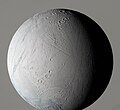Fichier:PIA06208.jpg

Fichier d’origine (1 013 × 930 pixels, taille du fichier : 84 kio, type MIME : image/jpeg)
Ce fichier et sa description proviennent de Wikimedia Commons.
Description
| DescriptionPIA06208.jpg |
English: Original Caption Released with Image:
During its very close flyby on March 9, 2005, the Cassini spacecraft captured this false-color view of Saturn's moon Enceladus, which shows the wide variety of this icy moon's geology. Some geological regions on Enceladus are old and retain large numbers of impact craters; younger areas exhibit many generations of tectonic troughs and ridges. Subtle differences in color may indicate different ice properties, such as grain sizes, that will help unravel the sequence of geologic events leading to the current strange landscape. This false-color view is a composite of individual frames obtained using filters sensitive to green (centered at 568 nanometers) and infrared light (two infrared filters, centered at 752 and 930 nanometers respectively). The view has been processed to accentuate subtle color differences. The atmosphere of Saturn forms the background of this scene (its color has been rendered grey to allow the moon to stand out). The Sun illuminates Enceladus from the left, leaving part of it in shadow and blocking out part of the view of Saturn. This view shows the anti-Saturn hemisphere, centered nearly on the equator. The images comprising this view were taken with the Cassini spacecraft narrow-angle camera at a distance of approximately 94,000 kilometers (58,000 miles) from Enceladus and at a Sun-Enceladus-spacecraft, or phase, angle of 48 degrees. Resolution in the image is about 560 meters (1,800 feet) per pixel. The Cassini-Huygens mission is a cooperative project of NASA, the European Space Agency and the Italian Space Agency. The Jet Propulsion Laboratory, a division of the California Institute of Technology in Pasadena, manages the mission for NASA's Science Mission Directorate, Washington, D.C. The Cassini orbiter and its two onboard cameras were designed, developed and assembled at JPL. The imaging team is based at the Space Science Institute, Boulder, Colo. |
| Date | Prise le 9 mars 2005 |
| Source | http://photojournal.jpl.nasa.gov/catalog/pia06208 |
| Auteur | NASA/JPL/Space Science Institute |
Cette image ou vidéo a été cataloguée par le Jet Propulsion Lab de la National Aeronautics and Space Administration (NASA) des États-Unis sous Photo ID : PIA06208.Ce bandeau n’indique rien sur le statut de l’œuvre au regard du droit d'auteur. Un bandeau de droit d’auteur est requis. Voir Commons:À propos des licences pour plus d’informations. Autres langues :
العربية ∙ беларуская (тарашкевіца) ∙ български ∙ català ∙ čeština ∙ dansk ∙ Deutsch ∙ English ∙ español ∙ فارسی ∙ français ∙ galego ∙ magyar ∙ հայերեն ∙ Bahasa Indonesia ∙ italiano ∙ 日本語 ∙ македонски ∙ മലയാളം ∙ Nederlands ∙ polski ∙ português ∙ русский ∙ sicilianu ∙ slovenščina ∙ Türkçe ∙ українська ∙ 简体中文 ∙ 繁體中文 ∙ +/− |
Conditions d’utilisation
| Public domainPublic domainfalsefalse |
| Ce fichier provient de la NASA. Sauf exception, les documents créés par la NASA ne sont pas soumis à copyright. Pour plus d'informations, voir la politique de copyright de la NASA. |  | |
 |
Attention :
|
Journal des téléversements d’origine
Transféré de en.wikipedia à Commons utilisant For the Common Good.
| Date et heure | Dimensions | Utilisateur | Commentaire |
|---|---|---|---|
| 06:52, 27 April 2005 | 1,013 × 930 (85,819 bytes) | w:en:Atitarev (d | contributions) | (Original Caption Released with Image: During its very close flyby on March 9, 2005, the Cassini spacecraft captured this false-color view of Saturn's moon Enceladus, which shows the wide variety of this icy moon's geology. Some geological regions on En) |
Légendes
Éléments décrits dans ce fichier
dépeint
9 mars 2005
Historique du fichier
Cliquer sur une date et heure pour voir le fichier tel qu'il était à ce moment-là.
| Date et heure | Vignette | Dimensions | Utilisateur | Commentaire | |
|---|---|---|---|---|---|
| actuel | 26 août 2012 à 08:16 |  | 1 013 × 930 (84 kio) | Bulwersator | Transferred from en.wikipedia: see original upload log above |
Utilisation du fichier
La page suivante utilise ce fichier :
